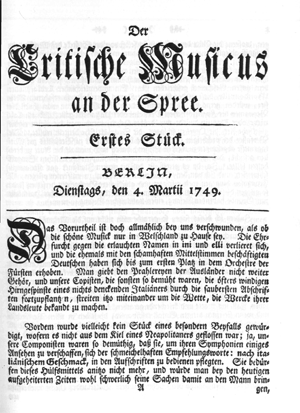Des critische Musicus an der Spree
Prepared by Alexander Staub
Online only (2023)

The weekly journal Des Critische Musicus an der Spree [RIPM code DCM] appeared between 3 March 1749 and 17 February 1750 in altogether 50 issues, with each issue bearing the title Der critische Musicus an der Spree without the declined initial article. It was published by Friedrich Wilhelm Marpurg, who did not reveal his name, rather writing under pseudonyms such as Philomusus, Wahrmund, Musenhold, and so forth. Marpurg, who in 1749 became secretary to General Friedrich Rudolf von Rothenburg, dedicated the periodical to his employer. Des Critische Musicus an der Spree could be acquired by subscription in Berlin "bey A. Haude und J. C. Spener, Königl. und der Academie der Wissenschaften privil. Buchhändler" (from A. Haude and J. C. Spener, privileged booksellers to the King and the Academy of Sciences) as well as in Breslau, Frankfurt/Main, Hamburg and Leipzig at the price of one Groschen per issue.
Most issues comprise 8 pages, though some are marginally longer. The weekly appearance was interrupted only between nos. 46 (13 January 1750) and 47 (27 January 1750), in which two weeks separated these issues.
The periodical is more enlightening than educational. Its aim was firmly to establish the format of a weekly music journal and to gather in a central place reprinted extracts of the important writings on aesthetics and particularly music aesthetics. Marpurg favored the stylistic device of speech and reply in the form of letters to the editor with responses, in a style of polemic confrontation, so as to expose outmoded prejudices and serious weaknesses by means of an unsparing yet persuasive satirical approach.
A treatise on basic musical matters—in fact a systematic discourse on harmony and counterpoint—was loosely continued across all the issues. Much space was given to the controversy between Marpurg and Johann Friedrich Agricola (pseudonym "Olibrio, reisender Liebhaber der Musik von der Tyber," or Traveling music lover from the Tyber) on the advantage of Italian versus French music and the existence of a German national taste represented by Johann Sebastian Bach. Nicolas Racot de Grandval’s similarly substantial "Versuch über den guten Geschmack in der Musick" (Essay on Good Taste in Music) emphasized the importance of emotions and the exaggerated dependence on external rules. The aesthetic focus of the journal was highlighted by the translation of the treatise "Versuch über den Verfall des guten Geschmacks in der Musik" (Essay on the Decline of Good Taste in Music) by Louis de Bollioud-Mermet. Marpurg’s instructions on performance practice, valuable to every type of musician, were followed in issues 37 and 38 (11 and 18 November 1749) by specific advice for organists including suggested registrations.
Six copperplates with music examples accompanied the journal, and no. 18 (1 July 1749) also contained the first edition of the poem "Der du, für dich, und uns, der Töne Kräfte kennst" (on the regulation of the pleasant sciences, especially of poetry and music) by the twenty-year-old Gotthold Ephraim Lessing.
Before the mid-eighteenth century hardly any efforts were undertaken in Germany to foster the flowering of a specific German musical style. The Italian and French tastes predominated, and music classification proceeded irrespective of the fact that Germany already boasted its own prominent proponents of a national musical idiom. Marpurg’s significance lies in his often-relentless way of widening the traditional perspectives by publishing polemical articles and in highlighting the unrecognized merits of his countrymen at a time when the German courts primarily fostered all things foreign.
